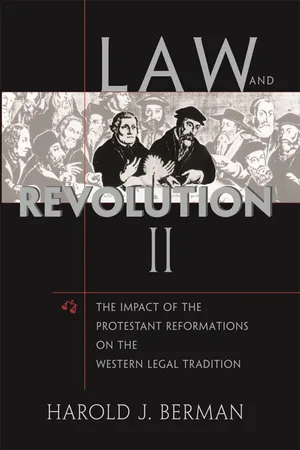
- English
- ePUB (mobile friendly)
- Available on iOS & Android
Law and Revolution
About this book
Harold Berman's masterwork narrates the interaction of evolution and revolution in the development of Western law. This new volume explores two successive transformations of the Western legal tradition under the impact of the sixteenth-century German Reformation and the seventeenth-century English Revolution, with particular emphasis on Lutheran and Calvinist influences. Berman examines the far-reaching consequences of these apocalyptic political and social upheavals on the systems of legal philosophy, legal science, criminal law, civil and economic law, and social law in Germany and England and throughout Europe as a whole.
Berman challenges both conventional approaches to legal history, which have neglected the religious foundations of Western legal systems, and standard social theory, which has paid insufficient attention to the communitarian dimensions of early modern economic law, including corporation law and social welfare.
Clearly written and cogently argued, this long-awaited, magisterial work is a major contribution to an understanding of the relationship of law to Western belief systems.
Frequently asked questions
- Essential is ideal for learners and professionals who enjoy exploring a wide range of subjects. Access the Essential Library with 800,000+ trusted titles and best-sellers across business, personal growth, and the humanities. Includes unlimited reading time and Standard Read Aloud voice.
- Complete: Perfect for advanced learners and researchers needing full, unrestricted access. Unlock 1.4M+ books across hundreds of subjects, including academic and specialized titles. The Complete Plan also includes advanced features like Premium Read Aloud and Research Assistant.
Please note we cannot support devices running on iOS 13 and Android 7 or earlier. Learn more about using the app.
Information
NOTES
CCC | Constitutio Criminalis Carolina |
CR | Corpus Reformatorum, 28 vols. (Frankfurt am Main, 1834–1860) |
LW | Luther’s Works, ed. Jaroslav Pelikan, 55 vols. (St. Louis, 1956) |
WA | Martin Luther, Werke: Kritische Gesamtausgabe (Weimar, 1883) |
Introduction
Table of contents
- Cover
- Title
- Copyright
- Dedication
- Contents
- Preface
- Introduction
- I The German Revolution and the Transformation of German Law in the Sixteenth Century
- II The English Revolution and the Transformation of English Law in the Seventeenth Century
- Conclusion
- Notes
- Acknowledgments
- Index